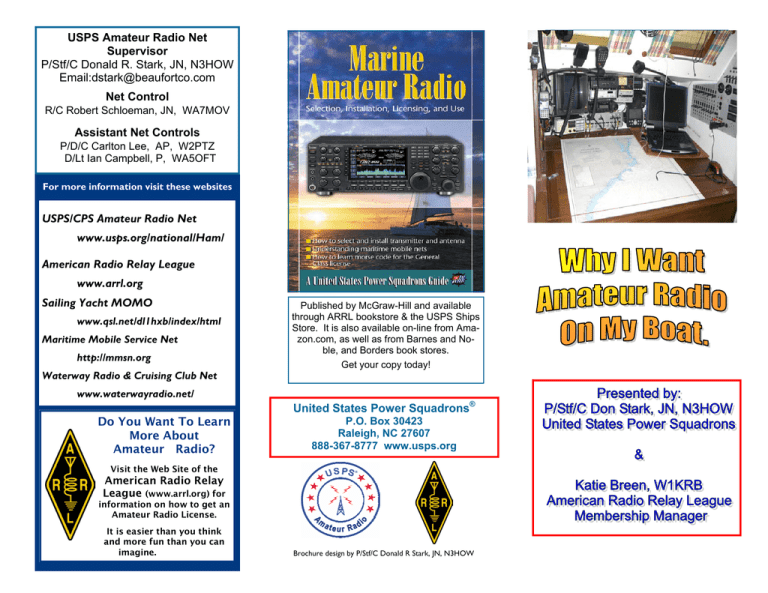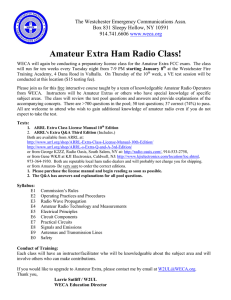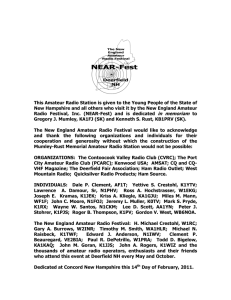information on Amateur Radio onboard a bost
advertisement

USPS Amateur Radio Net Supervisor P/Stf/C Donald R. Stark, JN, N3HOW Email:dstark@beaufortco.com Net Control R/C Robert Schloeman, JN, WA7MOV Assistant Net Controls P/D/C Carlton Lee, AP, W2PTZ D/Lt Ian Campbell, P, WA5OFT For more information visit these websites USPS/CPS Amateur Radio Net www.usps.org/national/Ham/ American Radio Relay League www.arrl.org Sailing Yacht MOMO www.qsl.net/dl1hxb/index/html Maritime Mobile Service Net http://mmsn.org Waterway Radio & Cruising Club Net Published by McGraw-Hill and available through ARRL bookstore & the USPS Ships Store. It is also available on-line from Amazon.com, as well as from Barnes and Noble, and Borders book stores. Get your copy today! www.waterwayradio.net/ Do You Want To Learn More About Amateur Radio? United States Power Squadrons® P.O. Box 30423 Raleigh, NC 27607 888-367-8777 www.usps.org Visit the Web Site of the American Radio Relay League (www.arrl.org) for information on how to get an Amateur Radio License. It is easier than you think and more fun than you can imagine. Brochure design by P/Stf/C Donald R Stark, JN, N3HOW Why do I want Ham Radio on my boat? Communications Safety Weather Nets How do I get a Ham Radio License? The three classes of licenses are: Technician: provides complete privileges on all ham frequencies above 30 MHz (including VHF & UHF) Low cost General: provides all privileges of Technician plus worldwide communications on the HF bands. Flexible use on a wide number of frequencies Extra: All of the above plus extra frequencies on four of the HF bands. Multi – Mode There no longer is any Morse Code requirement for any amateur radio license. Emergency Communications Maritime Nets give support to the Mariner. Medical help - Mechanical assistance Keep in touch with family and friends. Routing—filing of float plans. Email and digital communications. WinLink provides world wide communication by linking distant radios via the internet. APRS—Automatic Position Reporting System lets others follow your position via the internet. No passage need be lonely with Amateur Radio. You will have friends all around the world who will enjoy the cruise with you via amateur radio communications. Excellent learning materials are available from the American Radio Relay League and from other sources. You study the questions and answers from the FCC question pool. How do I set up a Ham Radio Station aboard my boat? Stations can be simple or complicated. For most communications aboard, the most important component is an effective antenna system which includes a good ground. There are many sources of information available explaining the proper installation of Amateur Radio Equipment including the USPS book Marine Amateur Radio published by McGraw-Hill and Amateur Radio on the Move published by the ARRL. There may seem to be a lot to learn, but you don’t have to do everything at once. Give it time and enjoy each step along the way. Make amateur radio your own. Local Hams and Ham Clubs will often assist the beginning ham. Often they teach classes in Amateur Radio theory and practice. Tests are given by Volunteer Examiners. Testing sessions are arranged usually by local amateur radio clubs. For a list of registered amateur radio clubs and testing sites, see the ARRL website (arrl.org). Only a small fee is charged for the test. There is no fee for the license. With a little bit of study and with a little bit of help you, too, can be on the air enjoying the camaraderie of amateur radio. Even Popeye enjoys talking on Ham Radio!

